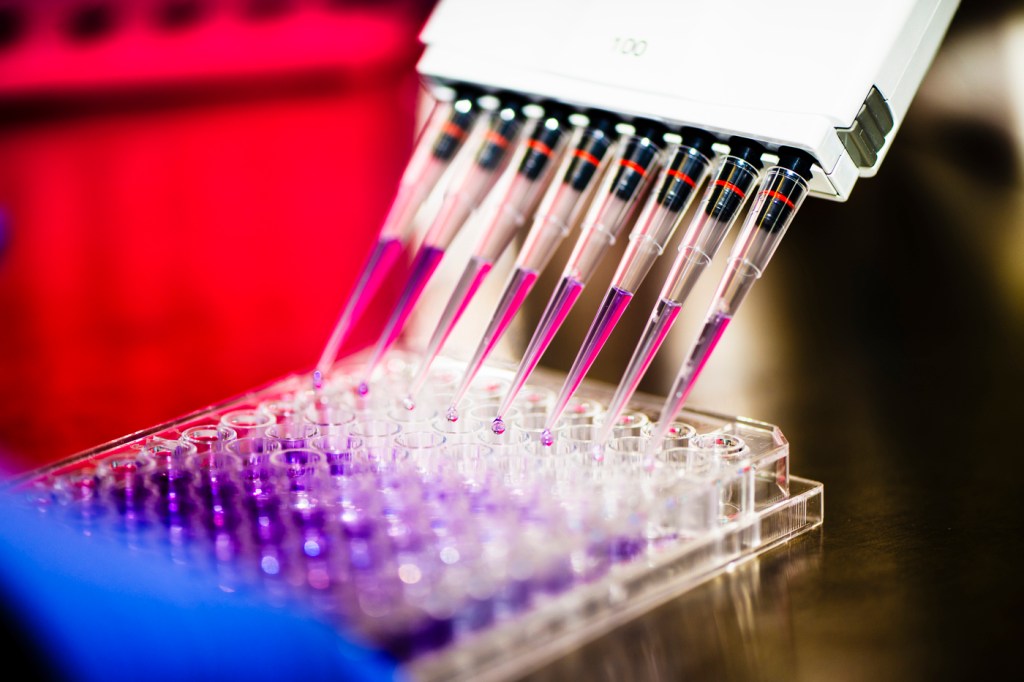Can AI help scientists develop drugs? Northeastern Institute for Experiential AI explores how the technology is reshaping pharmaceuticals

On March 11, 2020, the World Health Organization declared the COVID-19 outbreak a pandemic. Cases outside China had risen 13-fold and the virus was spreading rapidly.
Those first six months of the pandemic were challenging, says Sam Scarpino, AI+Life Sciences director at the Institute for Experiential AI at Northeastern, because we didn’t have great options to treat the disease.
In January of that year, scientists had identified the key spike protein of SARS-CoV-2, the virus that causes COVID-19, but antibody treatments for the disease were still a ways off. It wasn’t until months later, when scientists were able to extract antibodies from patients who had recovered from COVID-19 to develop proper therapeutics, Scarpino explains.
Artificial intelligence tools used for medical research could have helped cut that time in half, he says.
“With artificial intelligence in the loop, we could have had antibodies ready within three months of a target identification, which means we would have had therapeutic or even potentially transmission-blocking antibodies ready in time for that first wave in Boston,” he says. “That could have saved lives, kept schools opened, protected health care workers, etc.”
At Northeastern, Scarpino is working closely with researchers in a variety of domains in the university to use AI tools to help speed up the development of those kinds of treatments in preparation for future pandemics and other medical situations.

On Friday, Scarpino will host a webinar with Giulia Menichietti, faculty member of the Network Science Institute at Northeastern University, to talk about that work.
In the realm of medicine, AI tools are being used to help develop new drugs and medical treatments at the most fundamental part of the process, says Scarpino. AI is being used to synthesize and analyze the chemical compounds used to make drugs, deduce the efficacy and safety of those compounds, design clinical trials, and identify patient populations that could benefit from these drugs.
Featured Posts
“We have work in all of those spaces at Northeastern, so my role as the director of artificial intelligence and life sciences is to bring together faculty, research scientists, undergraduate students, Ph.D. students and master students to focus broadly on AI and drug discovery.”
Scarpino is particularly invested in the development of designing antibody treatments using machine learning models.
Collaborating within the university’s network of researchers working in wet and dry labs, he hopes to harness their data to train AI models to help develop medicines to treat rare and uncommon diseases.
He points to research being conducted by Northeastern chemistry professors Mike Pollastri and Lori Ferrins, who are working on drugs to treat neglected tropical diseases, as examples.
“They focus on pathogens like Trypanosoma cruzi (causes Chagas disease), malaria and Leishmaniasis. One of our goals at EAI, and in particular the life sciences research vertical that I coordinate, is identifying expertise inside of NU that can drive global impact,” says Scarpino.
The models the university is working on will be trained on small curated data sets, Scarpino says. By not having a reliance on large amounts of data, there will be less costs and development time. The institute will also tap into the expertise of Northeastern’s Network Science Institute, which takes an multidisciplinary approach to understand networking systems in the technological, biological, and informational domains.
“Instead of solving the problem by gathering bigger and bigger datasets, which is partly what groups like OpenAI have done with GPT 4. We’re trying to do it with smart data sets that are thoughtfully curated and designed,” he says. “That’s something we can do at a university uniquely well by working with researchers that have that wet lab experience and then bringing in AI models that can maximally leverage small data set techniques from network science.”











